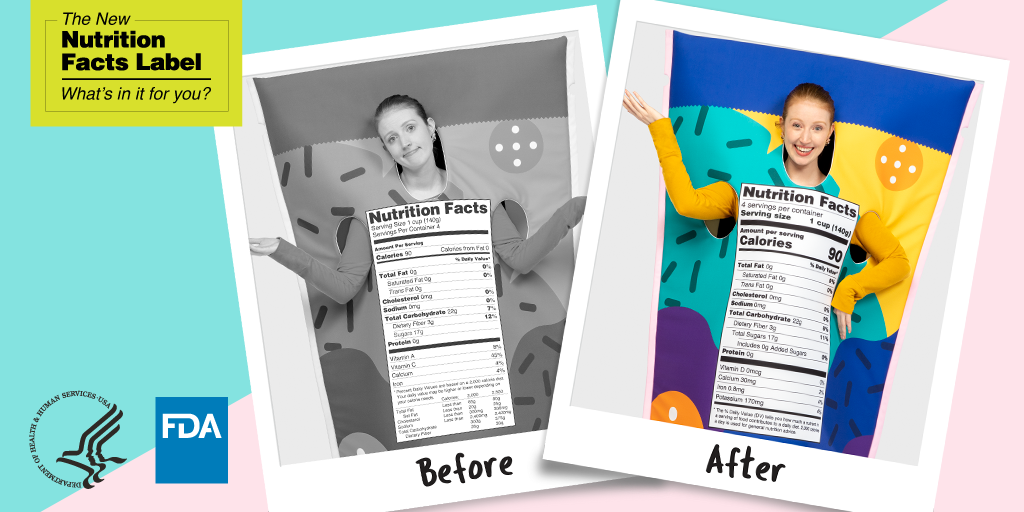The Ultimate FDA Food Labeling Guide
Written By: Leslie Taylor | Article Date: September 07, 2021
Every few years, the nutritional food label is updated to reflect updated scientific information and make it easier to understand the link between diet and diseases. In 2020, the Food and Drug Administration just made a significant label update—the first one in over 20 years.
While the nutritional label design still looks the same, the updates ensure that consumers make better and informed choices about their food. If you're about to print labels for the first time, this guide to food labels covers what you need to know when creating the updated FDA-compliant labels. We'll take you through the essential components to meet labeling requirements.
What Changes Were Made to the Nutrition Facts Label?

Several additions and modifications were made to the updated nutrition facts label.
These include changes to the serving size, calories, fat, Daily Values, and footnote. Vitamins A and C were removed, and the amount of micronutrients is listed in milligrams (mg).
The FDA has released detailed information about these label updates.
How to Create FDA-Compliant Food Labels
Before you begin, remember that label requirements must be evaluated for every unique product. The information provided in this guide is not all-inclusive. Depending on what type of food product you are selling, you may need to provide additional nutritional information and other essential details consumers should know.
Serving Size and Servings per Container
First, determine the serving size of your product according to the Reference Amount Customarily Consumed (RACC). The FDA developed the RACC acronym to determine the amount of food people typically consume rather than how much they should consume.Portion your product according to the RACC, then measure it in standard units that consumers can easily comprehend, such as cups, pieces, tablespoons, and grams.
Servings per container show the total number of servings in the entire food package or container.
It is common for one package of food to contain more than one serving. Once you've determined your serving size and servings per container, you can continue with the rest of the nutrition information.
Calories
Calories refer to the total number of calories, or "energy," supplied from all sources (carbohydrate, fat, protein, and alcohol) in a single serving of the food productIf you don't know the number of calories and nutrients your product contains, you can obtain the information using two popular methods. You can either send the product to an accredited food laboratory for testing or use computer software to calculate the data using the product's recipe, raw ingredients, and processing losses or gains.
Lab analysis is ideal for heavily processed products and foods that may contain allergens. However, this method can be costly and may take more time. Nutrition analysis software is more convenient and provides faster results but can also be expensive if you only have one or two food products for analysis.
Percent Daily Value
Nutrients
Note: You must list any vitamins and minerals added to the food or when you make a statement on the product label that says your product contains "high" or "low" amounts of a particular nutrient.
Ingredient List
The ingredients should be printed on the same panel as your nutrition facts. It can be placed either under the panel or above it. The list must state every ingredient present in your food product, in order of greatest to least.If any ingredient has sub-ingredients, you'll also need to list them down from greatest to least—for example, soy sauce (soybeans, wheat, salt, and a fermenting agent)
How to Customize Your Labels With NextDayFlyers
Aside from our standard label shapes and sizes, we also offer custom shapes and die-cutting options, which means we can trim your label in the exact size and shape of your design.
Print on a variety of high-quality adhesives suitable for indoor and outdoor applications. For general indoor applications, we have uncoated stocks such as premium white paper stickers and Estate adhesive papers. Need waterproof labels? We've got outdoor and refrigerator-safe materials like 4 mil. white vinyl and BOPP (biaxially-oriented polypropylene).
We also offer complimentary file checks, free templates, and an easy online design tool. This ensures your designs are press-ready and will print according to your exact requirements.
In a rush? Don't worry. We are the leading online printer for guaranteed printing turnarounds. Order custom food labels today, and we can get your prints ready for shipping in just a few business days.
Frequently Asked Questions
How soon can I receive my order?It depends on the type of labels that you order. You can use the product page order calculator to check the estimated delivery dates. Just input your preferred label specs such as size, material, quantity, add your ZIP code, and the website automatically generates shipping options and costs.
Can I order free printing samples?
Yes. You can request a free sample kit by filling out the request form. This kit includes printouts of our popular products. By ordering our sample kit, you can compare various materials and coatings to give you an idea of how your final printed piece will look before ordering.
Are your food packaging labels dishwasher safe?
We recommend choosing white vinyl or biaxially-oriented polypropylene material (BOPP) if you want dishwasher-safe labels.
Do you have coating options for labels?
Yes, we do. We have gloss and matte finishing options for most of our adhesives. These provide extra protection while enhancing your label designs.
Do I approve the design proof before you print the labels?
Yes, our prepress team will e-mail you a PDF document for your review. You can check for any design errors and make necessary changes before it goes to print. This process is free of charge and will be ready within 6 hours after you place your order.

